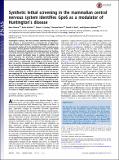Synthetic lethal screening in the mammalian central nervous system identifies Gpx6 as a modulator of Huntington’s disease
Author(s)
Kulicke, Ruth; Cowley, Glenn S.; Stein, Rachael; Root, David E.; Heiman, Myriam; Shema Tirosh, Reut; ... Show more Show less
DownloadShema-2015-Synthetic lethal scr.pdf (1.119Mb)
PUBLISHER_POLICY
Publisher Policy
Article is made available in accordance with the publisher's policy and may be subject to US copyright law. Please refer to the publisher's site for terms of use.
Terms of use
Metadata
Show full item recordAbstract
Huntington’s disease, the most common inherited neurodegenerative disease, is characterized by a dramatic loss of deep-layer cortical and striatal neurons, as well as morbidity in midlife. Human genetic studies led to the identification of the causative gene, huntingtin. Recent genomic advances have also led to the identification of hundreds of potential interacting partners for huntingtin protein and many hypotheses as to the molecular mechanisms whereby mutant huntingtin leads to cellular dysfunction and death. However, the multitude of possible interacting partners and cellular pathways affected by mutant huntingtin has complicated efforts to understand the etiology of this disease, and to date no curative therapeutic exists. To address the general problem of identifying the disease-phenotype contributing genes from a large number of correlative studies, here we develop a synthetic lethal screening methodology for the mammalian central nervous system, called SLIC, for synthetic lethal in the central nervous system. Applying SLIC to the study of Huntington’s disease, we identify the age-regulated glutathione peroxidase 6 (Gpx6) gene as a modulator of mutant huntingtin toxicity and show that overexpression of Gpx6 can dramatically alleviate both behavioral and molecular phenotypes associated with a mouse model of Huntington’s disease. SLIC can, in principle, be used in the study of any neurodegenerative disease for which a mouse model exists, promising to reveal modulators of neurodegenerative disease in an unbiased fashion, akin to screens in simpler model organisms.
Date issued
2015-01Department
Massachusetts Institute of Technology. Department of Brain and Cognitive Sciences; McGovern Institute for Brain Research at MIT; Picower Institute for Learning and MemoryJournal
Proceedings of the National Academy of Sciences
Publisher
National Academy of Sciences (U.S.)
Citation
Shema, Reut, Ruth Kulicke, Glenn S. Cowley, Rachael Stein, David E. Root, and Myriam Heiman. “Synthetic Lethal Screening in the Mammalian Central Nervous System Identifies Gpx6 as a Modulator of Huntington’s Disease.” Proc Natl Acad Sci USA 112, no. 1 (December 22, 2014): 268–272.
Version: Final published version
ISSN
0027-8424
1091-6490